The Great Ocean Garbage Patch: An In-Depth Exploration
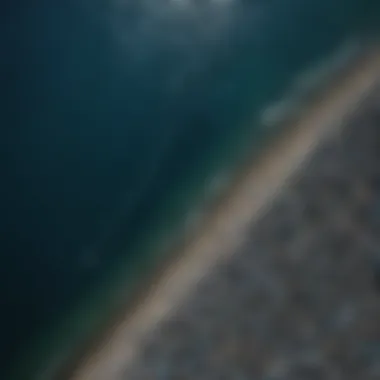
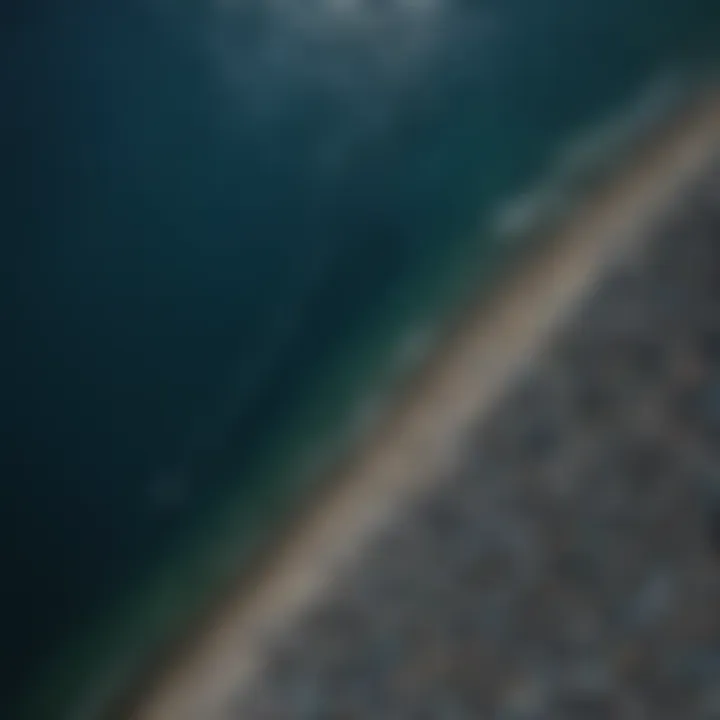
Research Overview
The Great Ocean Garbage Patch is a significant environmental issue, with far-reaching implications for marine ecosystems and human health. Recent studies indicate that these garbage patches are not merely clusters of debris but consist of microplastics and various forms of waste threatening marine biodiversity. Key findings reveal that pollutants accumulate in specific oceanic regions due to currents and wind patterns, creating swirling masses of debris. The most notorious of these regions is situated in the North Pacific Ocean, influenced by the North Pacific Gyre. This accumulation results from inefficient waste disposal practices, particularly in coastal regions.
Understanding the relevance of this research is critical. It highlights the urgent need for sustainable practices in waste management and the importance of preventing further pollution. The Great Ocean Garbage Patch serves as a poignant reminder that human actions directly impact the ocean's health. Investigating these issues aids in developing effective policies aimed at protecting marine life and maintaining ecological balance.
Methodology
To assess the extent and impact of the Great Ocean Garbage Patch, several research methodologies are employed. Scientists utilize a combination of satellite imagery and direct sampling to monitor debris concentrations.
The primary methods include:
- Hydrological Surveys: These surveys use vessels equipped with nets to collect samples of floating debris. Such efforts allow researchers to analyze the types of materials present and their potential origins.
- Satellite Observations: Satellites provide invaluable data on ocean currents and debris movement. This method helps in predicting future pollution patterns and assessing the overall distribution of marine litter.
Sampling criteria are crucial for the accuracy of the research. Strategic locations are selected based on current patterns, known pollution hotspots, and previous studies. Data is collected by deploying specialized boats which traverse predetermined paths, providing a comprehensive view of the pollution's extent.
"Understanding the origins and movements of marine debris is essential for crafting effective preventive measures against ocean pollution."
These methodologies are significant for understanding how the garbage patch develops over time and how it may be mitigated through international cooperation and sustainable practices. The implications of the findings extend beyond the immediate area, influencing discussions about marine conservation and public health on a global scale.
Prelude to the Great Ocean Garbage Patch
The Great Ocean Garbage Patch represents a major environmental concern that affects ocean health and marine ecosystems. Understanding this phenomenon is crucial for comprehending the broader implications of ocean pollution. Marine debris, most notably plastic waste, accumulates in certain areas of the ocean due to complex factors. This section will explore the definition, historical context, and significance of this increasing problem.
Definition and Description
The Great Ocean Garbage Patch refers to several areas of the ocean where large quantities of marine debris, predominantly plastic, collect. These regions are characterized by high concentrations of floating debris, resulting from factors such as ocean currents and human activities. The most well-known of these areas is the North Pacific Gyre, which contains a significant accumulation of waste.
This patch is not a solid mass, but rather a dispersal of microplastics and larger items that can travel across vast distances. The term often evokes images of a giant island of trash, but the reality includes tiny particles that are difficult to see. The challenges posed by this debris are immense, affecting marine life, ecosystems, and human health.
Historical Context
The emergence of the Great Ocean Garbage Patch is a relatively recent phenomenon, developing over the last few decades as plastic production and consumption increased dramatically. During the mid-20th century, plastics became ubiquitous in everyday items. With their low cost and versatility, plastics found their way into countless products. However, this convenience came at an environmental cost.
As these plastics break down slowly in the marine environment, they accumulate, forming what we now classify as garbage patches. The concept of the garbage patch became mainstream in the early 2000s, following researchers' findings that highlighted the scale and severity of the problem. Scientists have since worked to understand the phenomenon better and advocate for awareness and solutions.
"The ocean is a reflection of human activity, and the Great Ocean Garbage Patch underscores our impact on marine environments."
The ongoing expansion of this issue emphasizes the urgent need for effective strategies and policies aimed at mitigating the impacts of marine debris. Through education, awareness, and action, it is possible to address the challenges posed by the Great Ocean Garbage Patch in seeking sustainable practices within the broader context of environmental conservation.
Formation of the Great Ocean Garbage Patch
Understanding the formation of the Great Ocean Garbage Patch is essential for grasping the extent and implications of marine pollution. The patch's existence is intrinsically linked to both natural oceanic processes and human activities. It is not merely a random accumulation of waste, but rather a structured phenomenon shaped by the dynamics of the ocean and the behavior of substances introduced into it. Given the global nature of ocean currents, the garbage patch exemplifies how interconnected our environmental challenges are.
Ocean Currents and Gyres
The ocean is a vast network of currents that circulate water around the globe. Various factors, including wind patterns, the Earth's rotation, and the configuration of coastlines, contribute to these currents. Among the notable currents are gyres, which are large-scale circular patterns. Five major gyres exist in the world’s oceans, and they play a crucial role in the formation of garbage patches.
The North Pacific Gyre, for example, serves as a trap for marine debris. As ocean currents converge within this area, they create a sort of whirlpool effect that pulls in floating materials from all directions. Over time, these materials accumulate, forming what is known as the Great Pacific Garbage Patch. This phenomenon illustrates how the forces of nature can aid in concentrating waste in specific areas, complicating cleanup efforts.
Several studies have shown the speed at which debris can accumulate. A 2018 report highlighted that the North Pacific Ocean can trap up to 1.8 million tons of plastic debris. Such figures demonstrate the persistent nature of marine debris and the challenge it presents for environmental stewardship. The persistence of these materials emphasizes the need for significant intervention and policy change regarding waste management and disposal practices.
Human Contributions to Marine Debris
Human activities are the primary contributors to the formation of the Great Ocean Garbage Patch. These contributions come from numerous sources and manifest in various forms of debris. From single-use plastics, like bags and bottles, to discarded fishing nets and other industrial waste, human impact is undeniable.
The following highlights major sources of marine debris:
- Single-use plastics: Items designed for short-term use, such as straws and cutlery, often end up in ocean waters.
- Fishing gear: Abandoned, lost, or discarded fishing nets significantly contribute to marine pollution, entangling marine life and damaging ecosystems.
- Wastewater disposal: Improperly managed wastewater can introduce harmful plastics into waterways, eventually entering the oceans.
- Land runoff: Rain can wash debris from urban areas into rivers and ultimately to the ocean.
Recent data indicates that nearly 80% of ocean debris originates from land-based sources. This statistic underscores the urgent need for improving waste management practices and enhancing public awareness on how littering behaviors contribute to larger environmental issues.
"Each piece of plastic that reaches the ocean may take hundreds of years to degrade, wreaking havoc on marine ecosystems during that time."
The drastic impacts of human contributions to marine debris necessitate a multifaceted approach to address the issue, including regulatory frameworks, public engagement, and developing technologies aimed at reducing plastic consumption.
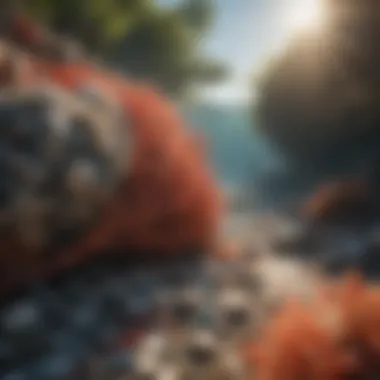

Thus, the formation of the Great Ocean Garbage Patch serves as a poignant reminder of our collective responsibility in managing waste and highlights the interconnectedness of human activity and ocean health.
Composition of the Oceanic Garbage
Understanding the composition of the oceanic garbage is crucial in addressing the issue of marine plastic pollution. The Great Ocean Garbage Patch is not just a singular entity but a complex mixture of various types of debris. Identifying the components of this waste helps in crafting effective mitigation strategies. Each type of debris has distinct properties and impacts on marine life, ecosystems, and human health.
This composition highlights the role of human activity in contributing to ocean pollution. By recognizing how different materials persist in the marine environment, we can prioritize research, education, and policy-making in a more informed way.
Types of Debris
The debris in the Great Ocean Garbage Patch can be classified into several categories.
- Microplastics: Small plastic pieces, often less than 5mm in size, resulting from the breakdown of larger plastic items.
- Nets and Fishing Gear: Abandoned or lost fishing equipment that continues to trap marine organisms.
- Bottles and Containers: Plastic, glass, and metal containers that contribute to the bulk of visible waste.
- Foam and Packaging Materials: Items such as expanded polystyrene, which are lightweight and easily carried by ocean currents.
- Rubber and Tires: Pieces from tires that wash into the ocean, contributing to the pollution.
Awareness of these types alerts researchers to the specific challenges they present. For example, microplastics can enter the food chain and bioaccumulate in aquatic life.
Microplastics and Their Effects
Microplastics have garnered attention in recent years due to their pervasive presence in marine environments. They originate from various sources, including the degradation of larger plastic items and products such as synthetic clothing that release fibers during washing.
The effects of microplastics on marine ecosystems are profound. Marine organisms mistake these tiny particles for food, leading to ingestion. This consumption can disrupt digestive processes and cause physical harm, such as blockages.
Moreover, microplastics can carry harmful chemicals. These chemicals may be toxic and can accumulate in marine organisms. As these organisms move up the food chain, the toxins can pose serious health risks to higher predators, including humans. Research continues to explore the full extent of these impacts, emphasizing the need for urgent action and ongoing monitoring of microplastic levels.
"Addressing plastic pollution requires a multifaceted approach that combines reduction, cleanup, and education efforts."
In summary, the composition of the oceanic garbage is essential to understanding the broader implications of marine pollution. By distinguishing types of debris and recognizing the particular threat posed by microplastics, we can engage more effectively in mitigating this growing environmental crisis.
Ecological Impact of the Garbage Patch
The ecological impact of the Great Ocean Garbage Patch encompasses numerous changes that disrupt marine ecosystems. Debris in the oceans affects not just the presence of biodiversity, but also the health of marine species. Understanding these impacts provides key insights into the broader ramifications of marine pollution. This section addresses how this debris affects marine life and biodiversity.
Effects on Marine Life
The garbage patch contains various types of debris that marine animals encounter daily. For instance, large plastics can entangle species such as sea turtles, seals, and birds. Entanglement can lead to injuries or death, impacting populations in the long term. Moreover, ingestion of plastic is another concern. Animals like fish and seabirds mistake plastic items for food. The consumption of these plastics leads to internal injuries, malnutrition, and often mortality.
Microplastics, small plastic particles less than five millimeters in size, pose a unique challenge. They can be easily ingested by a wide range of organisms, from zooplankton to larger fish. Studies indicate that toxins from microplastics may accumulate in the bodies of these species, leading to potential bioaccumulation in the food chain.
Marine species that rely on specific habitats are also at risk. For instance, coral reefs are susceptible to stress from both debris and pollutants. The presence of plastic can smother corals, blocking sunlight needed for their growth. As coral health declines, the entire ecosystem is affected.
"The effects of marine debris are profound and far-reaching, affecting not only individual species, but entire ecosystems."
Impact on Biodiversity
Biodiversity in ocean ecosystems is under significant threat due to pollution from the garbage patch. When species are impacted by debris, there are often cascading effects throughout the food web. A decline in keystone species, such as certain fish or marine mammals, can disrupt the balance of the ecosystem. Such imbalances can lead to overpopulation of certain species while others decline, which can ultimately result in a loss of biodiversity.
Furthermore, invasive species can be introduced via plastics floating into new habitats. These foreign species can outcompete native organisms for resources, leading to further ecological disruption. The result is a change in the structure of marine communities, which can takes years to recover, if they can recover at all.
In summary, the ecological impacts of the Great Ocean Garbage Patch present a critical challenge. Continued research efforts are necessary to better understand these dynamics. Preserving marine life and maintaining biodiversity requires urgent actions against plastic pollution.
Human Health and Safety Concerns
The significance of human health and safety in relation to the Great Ocean Garbage Patch cannot be overstated. As marine environments suffer from increasing pollution due to plastic waste, there are direct consequences that impact human populations. Understanding these concerns is essential in addressing broader public health issues and advocating for solutions.
Food Chain Contamination
Food chain contamination is one of the most pressing issues linked to the Great Ocean Garbage Patch. As plastics break down in the ocean, they do not simply disappear; instead, they fragment into smaller pieces, known as microplastics. These particles are consumed by marine organisms, ranging from tiny plankton to larger fish species.
The implications of this contamination extend beyond aquatic life. Humans often consume these fish and shellfish, leading to the ingestion of microplastics. It is estimated that people may consume up to 11,000 microplastic particles per year through seafood alone. This contamination poses significant risks, including:
- Accumulation of Toxins: Many plastics contain harmful chemicals that can leach into organisms and accumulate in their bodies, potentially entering the food chain.
- Influence on Nutritional Quality: The presence of microplastics in seafood does not just pose health risks; it can detract from the nutritional value of the food consumed.
- Public Health Risks: The long-term effects of microplastic consumption on human health are still being studied, but potential issues include endocrine disruption and increased cancer risk.
"The presence of microplastics in the food chain illustrates the interconnected relationship between human activity and marine environments."
Health Risks from Microplastics
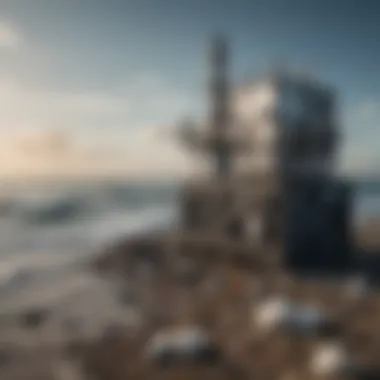

Microplastics also pose various health risks that require further investigation. These risks stem from both the physical presence of plastic particles and their potential to carry harmful contaminants. Potential health risks include:
- Chemical Exposure: Microplastics can adsorb pollutants from the surrounding environment, such as heavy metals and persistent organic pollutants. When ingested, these contaminants may cause adverse health effects.
- Inflammatory Responses: Studies show that microplastics can provoke inflammatory responses in various biological systems. The impact on human immune responses is still an area of research, needing more data to establish clear connections.
- Potential Pathogen Carriers: Microplastics can act as vectors for pathogens, which could pose further health risks should they enter the human digestive system.
Current Research and Monitoring Efforts
Research and monitoring of the Great Ocean Garbage Patch are crucial in understanding its dynamics and effects. This area contains high concentrations of marine debris, primarily plastic, which poses severe threats to marine ecosystems and public health. Addressing this issue efficiently requires solid scientific methodologies and collaborative efforts among researchers.
Scientific Methodologies
Understanding the Great Ocean Garbage Patch involves various scientific approaches. Researchers often use methods like remote sensing, in-situ sampling, and numerical modeling to gather data. Remote sensing, utilizing satellites, allows scientists to track and analyze large areas of the ocean for debris accumulation. This method provides a broad overview and highlights hotspots.
In-situ sampling involves physical collection of debris during research expeditions. Scientists use trawls and nets to gather samples of ocean water and debris. These samples are later analyzed in laboratories for composition, size, and density, offering insight into the types of plastics present in the patch. Numerical modeling also plays a role, as oceanographic models help simulate how currents transport debris, facilitating predictions about the movement and growth of the patch.
A combination of these techniques provides a comprehensive picture of the Great Ocean Garbage Patch. It helps identify trends and changes over time, revealing the extent of pollution and providing a basis for mitigation strategies.
Collaboration Among Scientists
Collaboration is essential for effective research on the Great Ocean Garbage Patch. Various scientific communities, including oceanographers, biologists, and environmental scientists, contribute unique perspectives and expertise. This multidisciplinary approach enhances the research quality and provides well-rounded insights.
International cooperation has increased in recent years. Collaborative efforts, such as the Ocean Cleanup Project, bring together scientists, engineers, and volunteers to develop innovative solutions for removing debris. Such projects exemplify how joint efforts can lead to more significant impacts in understanding and addressing marine pollution.
Government agencies and nonprofit organizations also play a vital role. Their funding and support enable extensive research projects and public awareness campaigns. Partnerships with local communities often enhance data collection and encourage participation in cleanup endeavors.
Mitigation Strategies
Addressing the Great Ocean Garbage Patch requires a multifaceted approach that includes various mitigation strategies. These strategies are essential in reducing the amount of plastic and other debris entering the oceans, and restoring ecological balance in marine environments. Understanding the significance of these strategies allows for a comprehensive approach to tackling the issue, while also engaging various stakeholders including policymakers, researchers, and the general public.
Sustainable Practices and Solutions
Implementing sustainable practices is a pivotal part of mitigating the impacts of the Great Ocean Garbage Patch. Many of these practices emerge from a desire to minimize waste at the source. One effective method is reducing single-use plastics. Consumers can switch to reusable bags, containers, and bottles instead of relying on disposable options. Encouraging businesses to adopt eco-friendly packaging alternatives can also substantially cut down waste production.
Education plays a critical role in establishing a culture of sustainability. Public awareness campaigns can inform communities about the challenges posed by marine debris and promote responsible waste disposal methods. This educational effort should extend beyond just consumers, reaching educators and students.
In addition, global collaborations for cleanups can provide both a visual impact and tangible benefits. Engaging communities in local beach cleanups fosters a sense of responsibility and connects people to their natural environments. These actions contribute significantly to reducing the existing waste in marine ecosystems while empowering citizens to take an active role in stewardship.
Technological Innovations
Technological innovations can serve as powerful tools in combating the Great Ocean Garbage Patch. One notable initiative involves the use of advanced materials and design processes to create more durable products that have less likelihood of becoming marine debris. Innovative recycling methods, such as chemical recycling, create possibilities for converting waste materials back into usable resources, further preventing additional plastic from entering the oceans.
Moreover, developments in artificial intelligence and machine learning support more effective monitoring of ocean pollution. By analyzing data from satellites and drones, scientists can identify hotspots and track changes in debris distribution over time. Such insights can inform focused cleanup efforts.
The integration of these technologies into management strategies addresses both prevention and remediation. Investing in research and development fosters a cyclic approach; identifying problems, creating solutions, and applying them effectively can lead to substantial progress in reducing marine litter.
"Innovative solutions are integral to addressing the severity of marine plastic pollution. Collaboration between scientists, the public, and governments is essential for maximizing the efficacy of these technologies."
Thus, both sustainable practices and technological innovations are crucial components of any comprehensive strategy aimed at reducing the Great Ocean Garbage Patch and preserving ocean health for future generations.
Global Initiatives and Policies
The topic of global initiatives and policies is crucial in addressing the ongoing issue of marine plastic pollution, particularly in the context of the Great Ocean Garbage Patch. International collaboration is essential to create effective frameworks that combat this environmental crisis. Various countries and organizations are working together to develop standards and regulations aimed at reducing plastic waste and its harmful effects on ocean ecosystems.
Current International Efforts
Many countries have recognized the need to address plastic pollution through coordinated efforts. The United Nations has played a significant role in this area by promoting treaties and agreements that encourage nations to take action against plastic waste. One notable initiative is the Basel Convention, which aims to control the transboundary movement of hazardous waste, including plastic materials.
Additionally, the Global Partnership on Marine Litter seeks to address marine litter through a collaborative approach. Countries participating in this partnership work on implementing best practices and sharing information on effective waste management strategies.
Moreover, international days like World Oceans Day promote awareness and motivate countries to enact policies that will protect marine environments. Governments are encouraged to implement bans on single-use plastics and improve recycling rates, which contribute to minimizing plastic entering the oceans.
Role of NGOs and Community Engagement
Non-governmental organizations (NGOs) play a significant role in the fight against ocean pollution. They often serve as advocates, driving public awareness and influencing policy changes at local and global levels. For instance, organizations like Ocean Conservancy and The Ocean Cleanup have made remarkable strides in collecting data and developing innovative solutions for ocean cleanup.
Community engagement is also vital. Local communities are at the forefront of tackling litter and can directly influence changes through grassroots movements. Engaging citizens in cleanup efforts not only fosters a sense of ownership of local environments but also helps to showcase the impacts of marine debris.
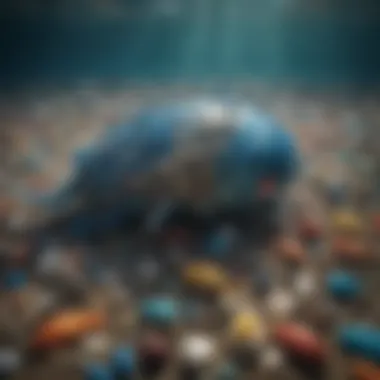
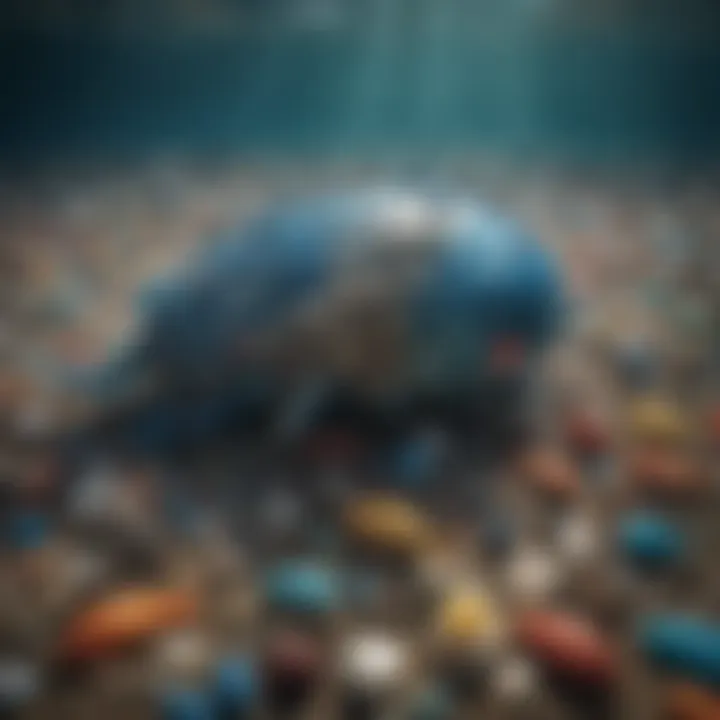
"Collective actions at both the local and international levels can create a meaningful impact on the reduction of waste entering our oceans."
Effective collaboration between NGOs, communities, and policymakers is essential for fostering sustainable practices. As individuals participate in community cleanup events, they learn about the consequences of littering and become motivated to change their behaviors regarding plastic consumption.
Future Directions for Research
Research into the Great Ocean Garbage Patch is crucial for understanding and mitigating marine debris issues. As the situation evolves, identifying future directions for study is essential to address the increasingly complex problems associated with ocean waste. This section explores key areas that deserve attention, focusing on new methodologies, collaborative research efforts, and improved tracking systems.
Emerging Areas of Study
Some emerging areas of study focus on the plastic lifecycle and its impacts. Here are a few significant topics:
- Microplastics: Understanding the origins and breakdown of microplastics is vital. Research on how they enter the food web can inform environmental policies.
- Chemical Effects: Investigating the toxicological impacts of plastics, including additives like phthalates and bisphenols, on marine organisms. More knowledge can lead to better regulatory measures.
- Alternative Materials: The use of biodegradable alternatives to conventional plastics is gaining interest. Research on the efficacy and environmental impact of these materials is crucial for future manufacturing practices.
- Public Perceptions: Understanding how public attitudes influence plastic use and waste management can drive effective educational campaigns and policy changes. Social science research can provide insights into behavior modification.
Exploring these areas will ensure a comprehensive understanding of how to combat plastic pollution.
Long-Term Monitoring Needs
Long-term monitoring is critical to track the movements and degradation of plastics within the oceans. Significant aspects include:
- Satellite Monitoring: Utilizing advanced technology for satellite imagery to assess the distribution and concentration of garbage patches over time can yield valuable data for researchers.
- Data Collection Protocols: Consistent and standardized methodologies for sampling debris types and concentrations are necessary for meaningful comparisons across studies.
- Biannual Assessments: Regular assessments of marine ecosystems in areas affected by garbage patches can help gauge the health of marine life. These assessments should include biodiversity indicators and physical hazards from debris.
- Innovative Tracking Technologies: Developing new tracking systems, like smartphone applications, could engage the public in reporting debris sightings. This citizen science approach can enhance data collection and raise awareness.
"Without continuous effort in monitoring, many insights into marine plastics will remain dormant, hindering effective policy implementations."
Public Awareness and Education
Public awareness and education are critical facets in tackling the issue of the Great Ocean Garbage Patch. The pervasive impact of marine plastic pollution necessitates a well-informed public that understands the complexities and implications of this environmental crisis. When individuals are educated about the origins and effects of plastic waste in the oceans, they are more likely to adopt sustainable practices. This understanding significantly influences collective action and policy change, essential in mitigating the problem of ocean debris.
An informed populace can foster a culture of accountability regarding personal consumption habits. Increased awareness creates a ripple effect, encouraging individuals to participate in broader discussions about sustainability. Programs that provide information about the environment enhance knowledge related to ecosystem health and the specific threats posed by plastic waste.
Importance of Environmental Education
Environmental education serves as a pivotal tool in addressing marine pollution. By integrating ecological literacy into educational curricula, institutions can equip students with the knowledge to critically examine their relationship with the environment. Carrying this education into adulthood shapes environmentally responsible behaviors and emphasizes the importance of conservation. Through workshops, seminars, and engaging materials, students and the public alike can learn about the adverse effects of the Great Ocean Garbage Patch.
Moreover, understanding the interconnections between consumer behavior and ecological health can inspire proactive steps toward reducing plastic use. It promotes awareness of alternative solutions, such as using reusable products and participating in local recycling initiatives.
Engaging Communities in Cleanup Efforts
Community engagement in cleanup efforts directly contributes to the mitigation of the Great Ocean Garbage Patch. These grassroots initiatives often galvanize local populations, demonstrating the power of collective action. When communities organize beach cleanups or awareness campaigns, it fosters a sense of ownership over local environments. This engagement extends to various demographics, ensuring that everyone plays a role in addressing marine debris.
Moreover, local cleanup events often serve educational purposes in themselves. Members of the community can learn about the type of debris collected, its sources, and its potential impacts. These interactive experiences deepen the understanding of marine pollution, making the issue more relatable and immediate.
"Collectively, cleanup efforts not only address the visible impacts of ocean litter but also cultivate a culture of environmental stewardship."
End
Understanding the Great Ocean Garbage Patch and its implications is crucial. The problem of marine plastic pollution extends beyond the surface of the ocean, affecting ecosystems, wildlife, and human health. In this article, we have dissected the various dimensions of this issue, from its formation through ocean currents and human actions to its profound consequences for marine biodiversity.
The importance of summarizing both impacts and solutions cannot be overstated. By recognizing how marine life suffers from ingestion of microplastics and entanglement in debris, we can appreciate the critical need for immediate action. Solutions, such as reducing plastic consumption, enhancing recycling processes, and supporting cleanup initiatives, must gain traction to mitigate future damage.
A comprehensive understanding leads to informed actions. Knowledge equips society to advocate for sustainable practices. It encourages individual responsibility and inspires collaboration among various stakeholders, from policymakers to grassroots organizations. With the right steps, the degradation of our oceans can start to reverse, fostering healthier marine environments.
Summarizing the Impacts and Solutions
In reviewing the impacts of the Great Ocean Garbage Patch, it becomes evident that the ecological consequences are severe and multifaceted. Marine animals often ingest plastic debris, mistaking it for food, which can lead to malnutrition and death. Higher trophic levels are also affected when larger species consume those contaminated with plastics, thus entering the food chain.
Furthermore, biodiversity suffers as habitats become polluted. Coral reefs, vital to many marine species, are impacted by the presence of microplastics in the water, which impede their growth and resilience to other stressors.
Solutions must address both the symptoms and root causes of the problem. Initiatives such as cleanup efforts by organizations like the Ocean Cleanup project show promise, but they must be accompanied by a larger framework to reduce plastic production and consumption.
Key Actions Can Include:
- Enhanced regulations on single-use plastics
- Increased public awareness campaigns regarding plastic pollution
- Collaboration across borders to manage ocean health collectively.
Call to Action for Individuals and Policy Makers
Individuals and policymakers play unique yet complementary roles in tackling the Great Ocean Garbage Patch. For individuals, taking responsibility begins with personal choices. Reducing reliance on single-use plastics, engaging in local cleanup activities, and promoting recycling can make a significant difference.
For policymakers, implementing stricter regulations on plastic manufacturing and waste management is essential. Policies that incentivize sustainable product designs and improve recycling infrastructure can help reduce oceanic waste.
"What we do today, right now, will have an accumulated effect on all our tomorrows." – Alexandra Stoddard
Thus, it’s vital to foster dialogue on marine conservation both at community levels and globally. Public engagement through education about the impacts of plastic on the oceans should be prioritized. By mobilizing communities and aligning with global conservation efforts, we can strengthen our resolve to protect these essential ecosystems.





